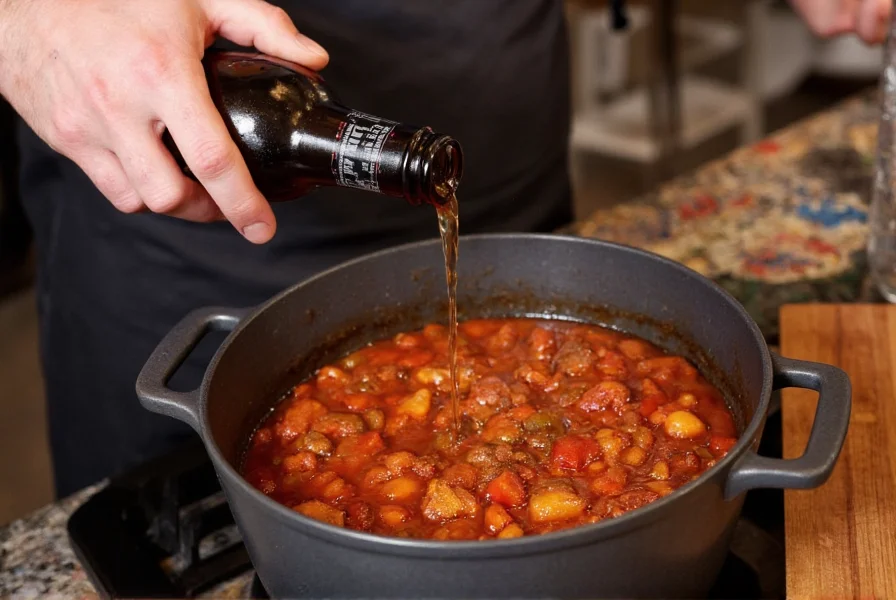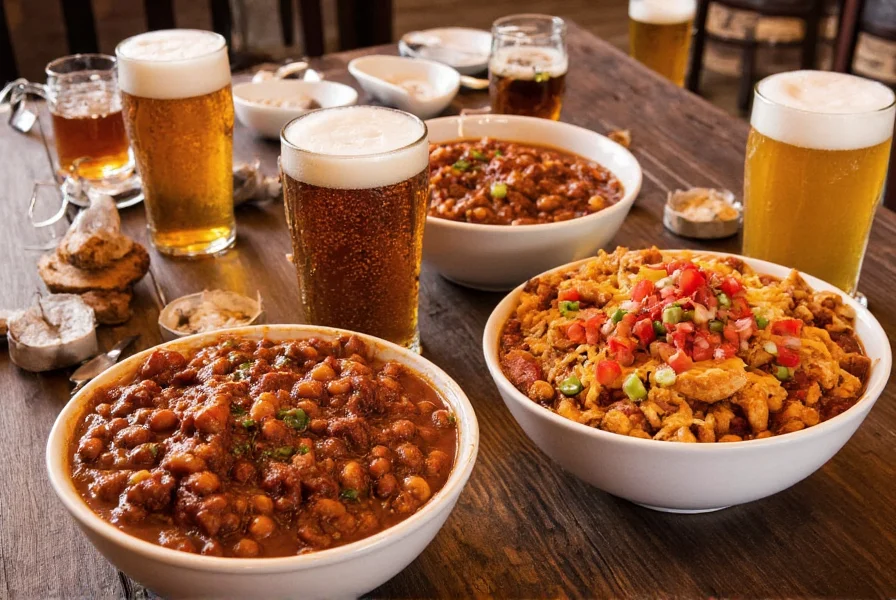When crafting the perfect pot of chili, selecting the right beer transforms your dish from ordinary to extraordinary. The ideal beer for chili balances malt sweetness with subtle bitterness to enhance rather than compete with complex spice profiles. Darker beer styles work best because their roasted notes harmonize with chili's smoky elements while their moderate carbonation cuts through richness.
How Beer Enhances Chili Flavor Profiles
Beer contributes three critical elements to chili: acidity, bitterness, and malt sweetness. The carbonation lifts heavy flavors, while hops provide balancing bitterness against chili's heat. Malt character adds depth that mimics the Maillard reaction from searing meat. When reduced during cooking, beer concentrates these flavors while the alcohol evaporates, leaving only nuanced complexity.
For authentic Texas-style beef chili, consider using a robust porter. Its chocolate and coffee notes complement beef's umami while softening the sharpness of cumin. In vegetarian bean chili, a malty amber ale adds caramel notes that enhance roasted vegetables without overwhelming delicate ingredients.
| Beer Style | Flavor Profile | Best Chili Type | Cooking Tip |
|---|---|---|---|
| Stout | Roasted malt, coffee, dark chocolate | Beef or game meat chili | Use 1 cup to deepen color and add smoky notes |
| Amber Ale | Caramel, biscuit, mild hop bitterness | All-purpose, especially bean chili | Add during simmering for balanced sweetness |
| Brown Ale | Nutty, toffee, low bitterness | White chicken or turkey chili | Substitute for broth to add subtle richness |
| Belgian Dubbel | Fruity, spicy, dark fruit notes | Complex spice blend chili | Use sparingly (1/2 cup) to avoid overpowering |
Why Hoppy Beers Don't Work Well in Chili
Many home cooks mistakenly reach for IPA when cooking with beer, not realizing how hop bitterness intensifies during reduction. As liquid evaporates, hop alpha acids concentrate, creating unpleasant bitterness that clashes with chili spices. The ideal beer for chili maintains a 20–40 IBU (International Bitterness Units) range—enough for balance but not enough to dominate.
When selecting the best dark beer for beef chili, prioritize malt-forward varieties with minimal hop presence. A well-made porter typically ranges between 25–35 IBU, making it superior to pale ales (40+ IBU) for cooking applications. The malt sweetness counteracts heat from chilies while enhancing the natural sweetness of tomatoes and onions.

Practical Cooking Techniques with Beer
Timing matters when adding beer to chili. Pour chilled beer directly into hot liquid to preserve volatile flavor compounds. The sudden temperature change causes immediate evaporation of harsh alcohol notes while retaining desirable aromatics. For optimal results, add beer after searing meat but before tomatoes—this allows acids to break down connective tissue without curdling dairy ingredients.
How to cook chili with beer properly requires patience. Simmer uncovered for at least 20 minutes after adding beer to ensure complete alcohol evaporation. Never use beer as the sole liquid—combine with broth in a 1:3 ratio (one part beer to three parts broth) to maintain proper consistency. For non-alcoholic alternatives, substitute with mushroom broth plus 1 teaspoon of instant coffee to mimic roasted malt notes.
Beer Pairing Strategies for Serving Chili
The same principles that guide cooking apply to serving. Beer pairing for spicy chili requires carbonation to cleanse the palate between bites. Serve chilled (40–45°F) in tulip glasses that concentrate aromas. For extremely spicy recipes, choose beers with residual sweetness like a Vienna lager to counteract heat without overwhelming flavors.
Consider regional pairings: A Colorado-style green chili pairs beautifully with a malty bock, while Cincinnati-style chili with chocolate notes demands a sweet stout. When serving beer with chili, pour smaller 6-ounce portions—the intensity of both demands moderation for optimal flavor appreciation.

Avoiding Common Beer and Chili Mistakes
Many cooks make critical errors when combining beer and chili. Using light lagers creates watery texture because their delicate flavors disappear during cooking. Adding beer too late in the process leaves harsh alcohol notes. Over-reducing concentrates unwanted bitterness from hops.
Amber ale vs stout for chili depends on your recipe's intensity. Stout works best with hearty meat chili but overwhelms vegetarian versions. Amber ale provides versatile middle ground but lacks depth for complex spice profiles. Always taste your beer before cooking—if it tastes unpleasant room temperature, it won't improve in chili.
Frequently Asked Questions
Can I use non-alcoholic beer in chili recipes?
Yes, non-alcoholic beer works well in chili. Choose malt-forward varieties like non-alcoholic stouts or amber ales. The flavor compounds remain intact even without alcohol, providing the same depth and complexity. Add during the same cooking stage as regular beer for identical results.
How much beer should I add to a standard chili recipe?
For a standard 6-quart chili batch, use 1–2 cups of beer to replace an equal amount of broth. Start with 1 cup, then adjust during simmering. Darker beers require less quantity than lighter styles because their flavors concentrate more during cooking. Never exceed 25% of your total liquid volume with beer.
Does the beer's expiration date affect chili flavor?
Yes, expired beer significantly impacts chili quality. Stale beer develops cardboard-like flavors from oxidized hops that transfer to your dish. Always use beer within 6 months of packaging date. Check for proper carbonation and fresh malt aroma before cooking—if it smells vinegary or musty, discard it regardless of date.
Which beer styles should I avoid when making chili?
Avoid highly hopped beers like IPAs, double IPAs, and pale ales as their bitterness intensifies during cooking. Steer clear of sour beers which clash with chili's acidity, and flavored beers containing fruit or spices that compete with your recipe's flavor profile. Light lagers lack sufficient malt character to contribute meaningful flavor.










 浙公网安备
33010002000092号
浙公网安备
33010002000092号 浙B2-20120091-4
浙B2-20120091-4